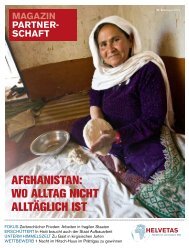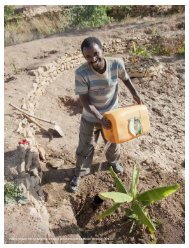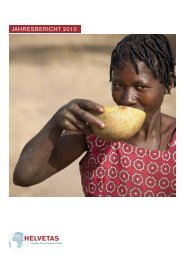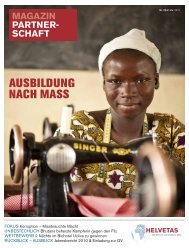Report Feasibility study organic bitter tea Cao Bang - Helvetas
Report Feasibility study organic bitter tea Cao Bang - Helvetas
Report Feasibility study organic bitter tea Cao Bang - Helvetas
Create successful ePaper yourself
Turn your PDF publications into a flip-book with our unique Google optimized e-Paper software.
<strong>Feasibility</strong> Study Organic Bitter Tea in <strong>Cao</strong> <strong>Bang</strong>: 2007<br />
even satisfy yet the domestic market) but also because of a lack of knowledge<br />
of these markets.<br />
2.3. Current status of <strong>organic</strong> agriculture in Vietnam<br />
Although it can be said that, as in all other countries in the world, all farmers were growing<br />
crops <strong>organic</strong>ally hundred years ago, <strong>organic</strong> farming according to the international<br />
understanding is quite new to Vietnam. Around 10 years ago some foreign companies<br />
started working with local companies and farmers to grow crops <strong>organic</strong>ally for export.<br />
After many years with only a few hundred hectares under <strong>organic</strong> management, there is<br />
presently an estimated 6,475 hectares of <strong>organic</strong> land (Willer & Yussefi, 2006). However,<br />
according to additional information collected by the consultant an additional 6000 - 7000<br />
ha has not been included in the report. The main <strong>organic</strong> products are herbs such as<br />
cinnamon, star anise and ginger, fruits, <strong>tea</strong>, cashew, shrimps and basa fish. These products<br />
are certified according to the standards of the importing countries, such as Europe and the<br />
USA, and foreign certification agencies carry out the inspection and certification work.<br />
The local market has not been developed at all, although one company tried to introduce<br />
<strong>organic</strong> vegetables to consumers in Hanoi some years ago. Few international and local<br />
organizations are supporting <strong>organic</strong> agriculture (main exceptions ADDA and GTZ). The<br />
Government also has no specific policies to support the development of <strong>organic</strong> agriculture<br />
in the country and as a result there is still little attention for <strong>organic</strong> farming from research<br />
and the extension service. However, in December 2007 the Ministry of Agriculture and<br />
Rural Development (MARD) issued national basic standards for <strong>organic</strong> production, which<br />
can now be used as a reference for producers, processors and others interested in <strong>organic</strong><br />
products for the local market. MARD is planning to set up a certification system for the<br />
local market but a timeframe for this activity has not been developed yet.<br />
3. WHY ORGANIC BITTER TEA FROM CAO BANG<br />
3.1. Assessment of the Bitter Tea Market<br />
In 2006, the <strong>Cao</strong> <strong>Bang</strong> <strong>bitter</strong> <strong>tea</strong> market chain was assessed using the Rapid Market<br />
Appraisal approach (RMA). The main objectives of the appraisal included:<br />
To analyse the actual state of the <strong>Cao</strong> <strong>Bang</strong> <strong>bitter</strong> <strong>tea</strong> market chain;<br />
To identify appropriate intervention actions in order to improve the <strong>Cao</strong> <strong>Bang</strong><br />
<strong>bitter</strong> <strong>tea</strong> market chain;<br />
To elaborate the concrete plan for the intervention actions.<br />
The RMA estimated that <strong>Cao</strong> <strong>Bang</strong> <strong>bitter</strong> <strong>tea</strong> has a share of about 10% of the domestic<br />
market, with the majority of <strong>bitter</strong> <strong>tea</strong> coming from China. With regards to the national<br />
production, the <strong>Cao</strong> <strong>Bang</strong> Bitter Tea Company (BTC) is the largest producer, with an<br />
annual return of around 1 billion VND per year (on a total turnover of around 4 billion<br />
VND). There are, however, also many smaller processors, who use the name (<strong>Cao</strong> <strong>Bang</strong>)<br />
<strong>bitter</strong> <strong>tea</strong> while allegedly they source their <strong>tea</strong> from China. (The shape of the BTC's <strong>bitter</strong><br />
<strong>tea</strong> is quite specific and very different from the shape of the Chinese <strong>bitter</strong> <strong>tea</strong>.)<br />
Market demand for <strong>bitter</strong> <strong>tea</strong> started to decline in 2004. As a result, the number of BTC<br />
outlets and distributors has declined across the country. Bud <strong>tea</strong> is still in high demand but<br />
the <strong>tea</strong> bags (using cut <strong>tea</strong> leaves and left-overs from the production of bud <strong>tea</strong>) are more<br />
- 3 -










